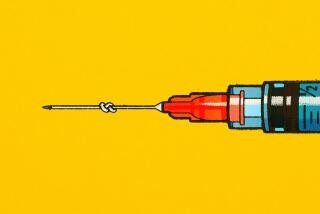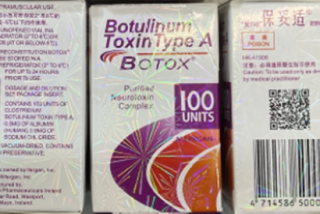The beautiful business of Botox
In his corner office, Mr. Botox looked his age.
He hadn’t had a shot of botulinum toxin in a while, and the furrow between his brows was back.
“You would never know I’m really 75 years old,” David E.I. Pyott said, trotting out a well-worn joke that he likes to make “because of who I am.”
He’s the man who made a muscle-controlling poison the most fashionable weapon against aging. And he’s really 54.
When Allergan Inc. hired him as chief executive in 1998, it was generating annual revenue of $1.26 billion turning out nasal sprays, eyedrops and optical devices. It still makes eyedrops but otherwise doesn’t much look like the company founded in an Irvine bean patch 60 years ago.
Now it’s a $3-billion corporation with global rights to the pharmaceutical industry’s first beauty blockbuster and a business plan -- based on battling glaucoma, wrinkles, obesity and incontinence -- written to fit an increasingly overweight nation packed with baby boomers.
Beyond that, Allergan has a development pipeline stuffed with potential remedies for a range of problems facing aging adults, including Alzheimer’s and Parkinson’s diseases. The company plows so much money into research that a few shareholders have complained.
Only a few, though. Revenue was up 34% last year; this year, as sales of Botox and most of its other products exceed forecasts, Allergan expects a 23% rise to $3.7 billion. Net income in the second quarter increased more than 40%.
“People have knocked them a little bit for spending so much” on R&D;, said Gary Nachman, an analyst with Leerink Swann in New York. “But that’s part of the genius.”
As is Allergan’s Botox promotion machine, according to doctors.
It stokes demand with slick television and magazine advertisements that share a lot with pitches for lipstick and hair color. They encourage physicians to view Botox as a “gateway drug,” one that may lead patients to demand other beauty treatments, such as Allergan’s Juvederm wrinkle filler, down the line. The company makes life easier for its “platinum physicians,” high-volume Botox buyers, with a quick-answer telephone line to order refills and gives free advice to doctors who ask how to better run their practices.
“They are an intelligent company,” said Tracy Hankins, a Las Vegas plastic surgeon with one of the biggest Botox practices in the country. “They think things through.”
The company has six research centers, including one that opened in Bangalore, India, in August. At the company’s 28-acre headquarters in Irvine, R&D; is in a complex of airy and art-filled modern buildings so packed with laboratories, wall-size whiteboards, laptop computers and textbooks it could pass for a medical school.
Of the 2,000 local employees, “1,000 are back there in lab coats,” Pyott said, waving his hand toward the hub of discovery and development behind the brown brick office tower where he works. At Allergan, he said, “research is the motor.”
The company’s strain of botulinum toxin is still an R&D; focus, even though, with more than 1,500 articles in medical and scientific journals devoted to it, the neurotoxin protein, highly poisonous in larger doses, is already one of the most researched medicines in the world.
No matter. Pyott said he expected the company to continue “chasing the doctors” -- developing and winning approval for new uses. As it is, Botox sales for aesthetic and therapeutic applications far exceed those of any other Allergan product, surpassing $1 billion last year and accounting for one-third of revenue.
Discovered in 1895 and approved in the U.S. as a cosmetic treatment in 2002, botulinum toxin isn’t rare. The company makes a year’s worth of Botox out of a single gram. The purified product is vacuum-sealed in clear, 100-unit vials that are shipped to physicians who pay $505 per vial and reconstitute the Botox with saline.
At 4 million injections a year and growing, the fountain of youth in a syringe is more than a cash cow. It’s a market creator. The wrinkle buster triggered a revolution in cosmetic medicine, driving it out of the operating room and into the doctor’s office, the spa and the mainstream.
“In the old days, if you lived in Cedar Rapids [Iowa] you’d have to drive a long way to get it,” Pyott said. “Now there’s somebody who can do it in every small town.”
In addition to dermatologists and plastic surgeons, gynecologists, general practitioners and others offer Botox. At up to $500 per wrinkled brow, Botox makes a tidy annuity for physicians because patients must return about once a quarter to maintain their smoother appearances.
The company acquired its strain of botulinum toxin in 1988 from a physician who had developed it to treat crossed eyes and a disabling blinking disorder. The toxin relaxed the overactive muscles that caused them.
Then ophthalmologists noticed that their patients’ frown lines disappeared after they received injections. One of them told her husband, who happened to be a dermatologist. Word spread, and dermatologists and plastic surgeons began to use Botox for wrinkles “off label” -- when a drug is legally prescribed for a purpose other than the use approved by the FDA.
The market exploded after Allergan invested in the required studies and obtained approval from federal regulators to market it as a cosmetic treatment. Pyott, who arrived at Allergan shortly after physicians began using Botox off label, became its biggest booster on a visit to a Minneapolis children’s hospital where Botox was helping young cerebral palsy victims walk.
By injecting Botox -- and interrupting the nerve impulses between the leg muscles and the brain -- doctors found that some children could even maneuver without splints. The injections managed to delay surgery and, in some cases, make such intervention unnecessary.
Pyott said he was never more proud to be Mr. Botox than the moment a patient’s parents spotted him and told him: “You’ve changed my child’s life.”
The visit opened Pyott’s eyes to the versatility of Botox, which he took to calling “a pipeline in a syringe.” He earned his nickname by pumping up the company’s Botox R&D; for a range of uses.
Today, juvenile cerebral palsy is one of 20 medical conditions for which Botox has been approved by regulators in more than 70 countries. Other indications include severe underarm sweating and cervical dystonia, a potentially disabling and painfully abnormal head position.
Next up: migraines and incontinence, for which Allergan expects to win approval from the Food and Drug Administration in the next few years.
For all that, the eye remains a primary focus for Allergan. It has been the fastest-growing ophthalmic company for six years and ranks No. 2 in the market. Half of its revenue comes from over-the-counter and prescription eye products.
Its marquee eye-care product, Restasis, is the only treatment for dry eyes that treats the underlying inflammation and prompts the eye to produce its own lubrication.
Restasis illustrates how Allergan’s long focus on eye problems “allows us to really know the area well and really be ahead of the curve,” research chief Dr. Scott Whitcup said.
To exploit the graying-of-America franchise, Allergan is buying companies with complementary products. Last year it was Inamed, which makes breast implants, an injectable gel called Juvederm that smooths smile lines and the Lap-Band, a minimally invasive device for the surgical treatment of obesity. This year it’s Esprit Pharma Inc., which sells time-released Sanctura capsules to fix age-related urinary problems.
Sanctura and its urology-savvy sales force will give Allergan experience in the incontinence market while it is developing Botox as another treatment for the problem.
“You buy the field next door if you are a farmer,” Pyott said. “And that’s what we’ve been doing.”
Allergan sales representatives are cross-selling, encouraging physicians to view Botox as an introduction to the broader array of treatments. Along with its “Everyone will notice, but no one will know” commercial sandwiched between segments of the hit show “Dancing With the Stars,” which has no doubt featured more than a few closeted users, the cross-selling is boosting Juvederm sales, taking market share away from competitor Restylane.
For Botox, the company recently hired a spokesmodel, actress Virginia Madsen, who has compared her openness about using Botox to Catherine Deneuve’s admission years ago that she dyed her hair.
“Clearly, all of these product markets are riding the global megatrends of the aging world population and the desire to remain active, vibrant and look better and more youthful,” Pyott told analysts recently.
“Spending to satisfy these needs appears to be inelastic to economic cycles.”
That means that once the crease in a patient’s brow has melted away, she’ll find a way to keep paying for Botox injections no matter how her stock portfolio is performing.
--
--
(BEGIN TEXT OF INFOBOX)
Allergan’s top lines
(Annual sales, in millions)
Botox
$1,150-1,180
Lumigan franchise
$370-390
Glaucoma treatment
Restasis
$320-340
Increases tear production
Alphagan franchise
$295-315
Glaucoma treatment
Breast aesthetics
$275-295
Obesity intervention
$235-255
Facial aesthetics
$160-190
--
Source: Allergan Inc.
--
Non-cosmetic uses for Botox
Cervical dystonia (abnormal movements and awkward posture caused by involuntary and sometimes painful contraction of neck muscles)
Strabismus (crossed eyes)
Blepharospasm (eyelids that close involuntarily)
Hyperhidrosis (sweaty palms)
Headache
Juvenile cerebral palsy
Overactive bladder
Adult spasticity (symptom of central nervous system injury)
Pain
More to Read
Inside the business of entertainment
The Wide Shot brings you news, analysis and insights on everything from streaming wars to production — and what it all means for the future.
You may occasionally receive promotional content from the Los Angeles Times.











